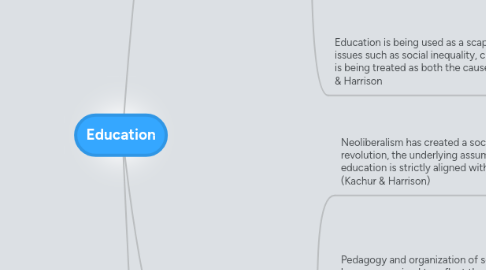
1. Sociological
1.1. The restructuring of Education in Alberta has served to decrease student opportunity and thus equality (Kachur & Harrison)
1.1.1. new teaching techniques can enhance development as seen in the goals of three E's in Education
1.1.1.1. learners of the 21st centuryhttp://www.youtube.com/watch?v=zDZFcDGpL4U
1.1.1.1.1. opportunity
1.1.1.1.2. fairness
1.1.1.1.3. citizenship
1.1.1.1.4. choice
1.1.1.1.5. diversity
1.1.1.1.6. excellence
1.1.1.2. Preparing students for their future, not our past
1.2. Education is producing social inequality by socializing students for their future roles as members of society. The government is suggesting that the best educated people get the best jobs, which is not necessarily the reality in Alberta (Kachur & Harrison)
1.2.1. In Alberta it is extremely possible to make money without an education. Ie. working on the rigs, Ralph Klein
1.2.2. Streaming
1.2.2.1. MMI and EMI (Davies & Guppy)
1.2.3. Tracking, formation of different ability groups within classrooms(Barakett & Cleghorn)
1.2.3.1. Assessment of learning vs. assessment for learning
1.3. Conflict theorists would suggest that education is a tool to widen the gap between the rich and the poor, the powerful and the powerless.
1.3.1. Credentials, knowledge becomes an economic resource and personal assett (Davies & Guppy)
1.3.1.1. Knowledge is power
1.3.2. reinforcing existing inequalities (Davies & Guppy)
1.3.2.1. parental credentials strong indicators for child's school success, family is the primary socializing unit (Barakett & Cleghorn)
1.3.2.1.1. Vs. Freud's psychoanalytic theory which relies heavily on biological factors (Barakett & Cleghorn)
1.3.2.1.2. Vs. Piaget and the cognitive perspective (Barakett & Cleghorn)
1.3.2.1.3. Vs. Mead and the development of self (Barakett & Cleghorn), Me mediates I
1.3.2.1.4. Vs. Shutz and the social interaction (Barakett & Cleghorn), accumulation of knowledge through experience, initially from parents
1.3.2.2. Racial inequalities rampant, in 2001 only 6.2 % of Aboriginal Canadians had attained a university degree. The lowest of visible minorities. (Davies & Guppy)
1.3.2.2.1. Alberta Education's promise to close the gap in education achievement between FNMI and other provincial students
1.4. Education is being used as a scapegoat to deal with societal issues such as social inequality, crime, racism, etc. Education is being treated as both the cause and the solution. (Kachur & Harrison
2. Philosophical
2.1. Neoliberalism has created a social and political revolution, the underlying assumption being that education is strictly aligned with economic success (Kachur & Harrison)
2.1.1. Politcal socialization and the the role that schools play in inculcating the values and norms that support the strucure of society (Barakett & Cleghorn)
2.1.1.1. The Hidden Curriculum, the latent assumptions learned within the school.
2.1.1.2. Is teaching politcally neutral? (Conrad)
2.1.1.2.1. everything we do is political, by being neutral you are inherently choosing one side
2.2. Pedagogy and organization of schools has been reorganized to reflect the needs of society
2.2.1. emphasis on math, science and technology as means to address Canada's productivity decline (Kachur & Harrison)
2.2.2. Teaching influences what and how students learn, messages about power and authority conveyed
2.3. Claim that teachers actively discriminate against lower-class students, preconceived conceptions of students (ie. race and class discrimination) (Davies & Guppy)
2.3.1. Social Equality/Inequality
2.3.1.1. Eugenics
2.3.1.1.1. Rob Wilson
2.3.1.2. Residential Schools
2.3.1.2.1. Jonathan Anuik
2.3.1.3. LGBTQ
2.3.1.3.1. Michael Phair
2.3.1.4. Special Education
2.3.1.4.1. IQ
2.3.1.4.2. categorization, DSM
2.3.2. Teacher Typifications of Pupils, an interpretive process
2.3.2.1. interpreting, defining and managing classroom behaviors
2.3.2.1.1. teachers cannot be static, always changing pedagogy
2.3.2.1.2. Willingness to modify instruction (Mark Yurick)
2.3.3. Teachers are bound to the ATA and the professional code of conduct
2.3.3.1. sets parameters for the ways teachers can act
2.3.3.1.1. Meda
3. Historical
3.1. Klein government and the significant changes to education in terms of funding, curriculum, programs and ideologies (Kachur & Harrison)
3.2. Canadian education over the 20th century has failed to bring more class equality (Davies & Guppy)
3.2.1. However, beginning in the 1950's the gender imbalance began to lessen. By 1987 more women then men were enrolled in post secondary.
3.3. Residential Schools and the historic and continued inequality of Aboriginal Canadians
3.3.1. The 1973 policy that restored control of First Nation education to First Nation People (Anuik)
3.3.1.1. Learning spirit that exists among FNMI is connected to the past, present, and future (Anuik)
3.3.1.1.1. Culturally relevant programs and pedagogy. resources and support
3.3.1.2. Contemporary initiatives and projects: Alberta Ed. is committed to improving educational outcomes for FNMI
